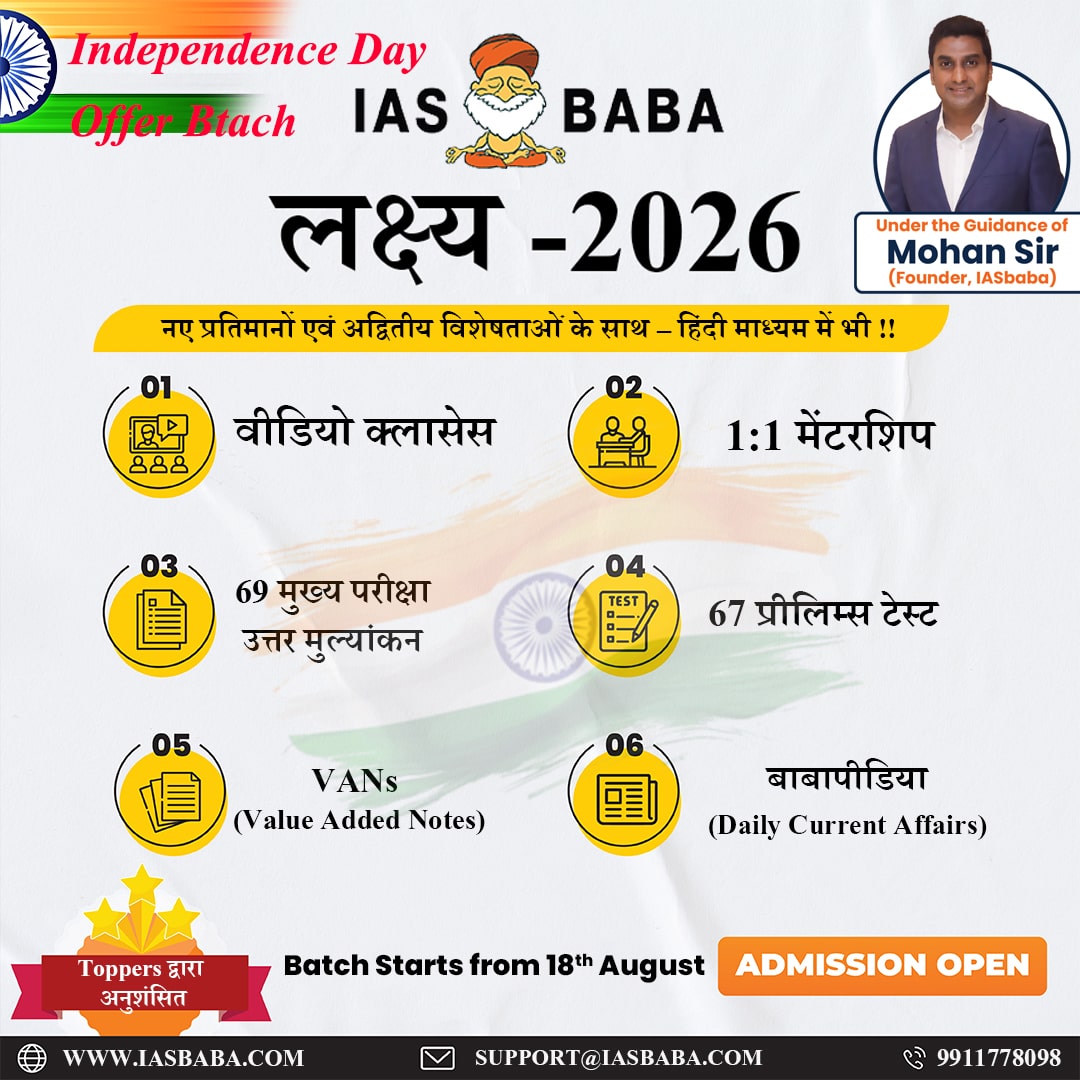IASbaba's Daily Current Affairs Analysis
Archives
(PRELIMS Focus)
Category: SCIENCE AND TECHNOLOGY
Context: India remains heavily reliant on imported aircraft engines, affecting its defence capabilities and strategic autonomy
Decoding Context:
Key Developments:
- HF-24 Marut:
India’s first indigenous fighter jet, developed in the 1950s-70s, underperformed due to lack of a powerful indigenous engine, relying instead on imported engines. - Kaveri Engine Project:
Launched in 1986 for the LCA Tejas, it failed to meet requirements even after decades of development and ₹2,000 crore in spending.
Why It Matters:
- Engine Dependency:
Recent disruptions (e.g., GE F404 engine delivery delays from the U.S.) highlight how foreign engine delays hinder military programs like the LCA Mk1A. - Import Bottlenecks:
India depends on imported engines for air, sea, and land systems—impacting tanks, submarines, aircraft, and ships. This creates strategic vulnerability. - Impact on Future Projects:
India’s 5th-gen AMCA and other defence programs risk delays unless engine self-sufficiency is prioritized.
Strategic Importance:
- Indigenous propulsion tech is crucial for:
- Sustained military readiness.
- Reducing foreign dependency.
- Withstanding geopolitical shocks.
- It’s not just a technical issue but a national security imperative.
Learning Corner:
HF-24 Marut (India’s first indigenous fighter jet)
- Developed by Hindustan Aeronautics Limited (HAL) in the 1950s with German assistance (engineer Kurt Tank).
- A milestone in India’s aerospace history.
- Faced engine issues due to lack of indigenous jet engine.
- Used underpowered British Orpheus engines.
- Retired in 1990 due to poor engine performance and limited upgrades.
Kaveri Engine Project
- Initiated in 1986 to power the LCA Tejas fighter.
- Developed by Gas Turbine Research Establishment (GTRE).
- Project delayed and unsuccessful due to technical challenges.
- ₹2,000+ crore spent without producing a viable combat-ready engine.
- Never inducted into the armed forces.
AMCA Programme
- India’s 5th generation Advanced Medium Combat Aircraft (AMCA).
- Needs a more powerful indigenous engine (110 kN thrust).
- HAL negotiating with GE to co-develop an engine for AMCA.
- PM Modi announced $1 billion GE-HAL partnership to manufacture GE-414 engines in India.
Source: THE HINDU
Category: HISTORY
Context: The Archaeological Survey of India (ASI) will organize a major international conference titled “Decipherment of Indus Script: Current Status and Way Forward”
Purpose and Structure
- Aims to bring together global scholars and researchers to discuss the undeciphered Indus script.
- Will feature thematic sessions, presentations (in-person and virtual), and discussions.
- Registration and paper submission deadline: June 30, 2025.
Background
- The Indus script, dating back to 3300–1300 BCE, remains undeciphered despite over a century of study.
- Found on seals, tablets, and pottery of the Harappan civilization across India, Pakistan, and Afghanistan.
Conference Goals
- Assess the current research status.
- Outline future research directions.
- Promote interdisciplinary collaboration and support young scholars.
Key Challenges
- Inscriptions are very short, limiting grammatical analysis.
- No bilingual texts exist for comparison.
- Underlying language remains unknown.
- Limited number and high symbol variation complicate interpretation.
Recent Developments
- Renewed global interest, including a $1 million prize for decipherment.
- New archaeological finds in Tamil Nadu show possible links to Indus symbols.
- Ongoing debates connect the script to Dravidian languages and other cultural traditions.
Learning Corner:
Indus Valley Civilization (IVC
- Time Period: ~3300 BCE to 1300 BCE
- Mature Phase: ~2600 BCE to 1900 BCE
- Geographical Extent: Spread across present-day Pakistan, and northwestern India (Haryana, Punjab, Gujarat, Rajasthan). Major sites include:
- Harappa (Punjab, Pakistan)
- Mohenjo-daro (Sindh, Pakistan)
- Dholavira (Gujarat, India)
- Rakhigarhi (Haryana, India)
- Kalibangan, Lothal, Banawali
Key Features of the Civilization
- Urban Planning: Grid-pattern streets, drainage systems, granaries, and citadels.
- Architecture: Use of burnt bricks, standardized weights and measures.
- Economy: Trade (including overseas with Mesopotamia), agriculture, crafts (beads, pottery, metallurgy).
- Society: Evidence suggests a relatively egalitarian structure; no clear evidence of kings or temples.
- Religion: No temples found; likely worship of nature, fertility cults, proto-Shiva (pashupati seal), mother goddess figurines.
- Decline: Gradual—due to environmental shifts (climate change, river drying), and possible socio-economic disruption.
Indus Script: Key Points
- Nature: Pictographic or logo-syllabic script found on seals, pottery, tablets, and copper tools.
- Undeciphered: Despite over a century of study, the script has not been conclusively deciphered.
- First Reported: In the 1931 excavation report of Mohenjo-daro.
- Writing Direction: Generally, right to left.
- Number of Symbols: Around 400–600 distinct signs.
- Usage: Mostly short inscriptions (average 5 symbols), often used on seals for trade or identification.
- Challenges in Decipherment:
- No bilingual inscriptions (like Rosetta Stone)
- Very short texts—no grammar context
- Unknown language base
- Variations in signs
Source: THE HINDU
Category: SCIENCE AND TECHNOLOGY
Context : Israël strike-hit Arak heavy water reactor was part of Tehran’s nuclear deal.
About Arak Heavy Water Reactor
- Located ~250 km southwest of Tehran, the Arak reactor has long been a global concern due to its capacity for producing weapons-grade plutonium.
- Originally designed to generate ~9 kg of plutonium per year—enough for one nuclear bomb annually.
Role in the 2015 JCPOA (Iran Nuclear Deal)
- Iran agreed to redesign the Arak reactor to prevent plutonium production.
- The original core was disabled and filled with cement.
- The International Atomic Energy Agency (IAEA) verified the reactor was made inoperable and monitored modifications.
Recent Developments (2025)
- June 19, 2025: Israeli airstrike damaged the reactor’s core seal and its heavy water production plant, aiming to prevent future weaponization.
- The reactor was not yet fueled, and the IAEA confirmed no radioactive risk.
- Concerns remain that Iran has not fully completed the redesign, with construction reportedly continuing and possible operation by 2026.
Learning Corner:
Types of Nuclear Reactors
Pressurized Water Reactor (PWR)
- Moderator & Coolant: Light water (H₂O)
- Fuel: Enriched uranium (~3–5% U-235)
- Working: Water is pressurized to prevent boiling; heat is transferred via a steam generator.
- Example: Most reactors in the USA and France
- India: Kudankulam Nuclear Power Plant (built with Russian technology)
Boiling Water Reactor (BWR)
- Moderator & Coolant: Light water
- Fuel: Enriched uranium
- Working: Water boils in the reactor core to generate steam directly for turbines.
- Example: Fukushima (Japan), Tarapur (India)
- India: Tarapur Units 1 & 2 (BWRs supplied by the US in the 1960s)
Pressurized Heavy Water Reactor (PHWR)
- Moderator & Coolant: Heavy water (D₂O)
- Fuel: Natural uranium
- Working: Uses pressurized heavy water as both moderator and coolant. Allows online refuelling.
- Example: CANDU (Canada), IPHWR (India)
- India: Rajasthan, Kakrapar, Kaiga, and other reactors.
Fast Breeder Reactor (FBR)
- Moderator: None
- Coolant: Liquid sodium
- Fuel: Mixed oxide (MOX) – plutonium + uranium
- Working: Produces more fissile fuel than it consumes (breeding plutonium from U-238).
- Example: Prototype Fast Breeder Reactor (PFBR), Kalpakkam (India)
- India: Key to Stage-2 of India’s 3-stage nuclear program.
Advanced Heavy Water Reactor (AHWR)
- Moderator & Coolant: Heavy water (moderator), light water (coolant)
- Fuel: Thorium + Uranium-233
- Working: Designed for India’s Stage-3 thorium program.
- India: Designed indigenously; under development by BARC.
Gas-Cooled Reactor (GCR/AGR)
- Moderator: Graphite
- Coolant: Carbon dioxide gas
- Fuel: Enriched uranium
- Example: AGR (UK), Magnox reactors
- Not used in India
Molten Salt Reactor (MSR) (Experimental)
- Fuel: Uranium or thorium dissolved in molten salt
- Coolant: Molten salt
- Advantages: High temperature, passive safety
- Status: Under research in USA, China; India exploring for thorium use.
Comparison Table (Summary)
| Type | Fuel | Moderator | Coolant | Key Feature |
|---|---|---|---|---|
| PWR | Enriched Uranium | Light Water | Light Water | Indirect steam generation |
| BWR | Enriched Uranium | Light Water | Light Water | Direct steam generation |
| PHWR | Natural Uranium | Heavy Water | Heavy Water | Online refueling, indigenous |
| FBR | MOX (Pu + U) | None | Liquid Sodium | Breeds Pu-239, high neutron economy |
| AHWR | Thorium + U-233 | Heavy Water | Light Water | Utilizes thorium cycle |
| GCR/AGR | Enriched Uranium | Graphite | CO₂ Gas | Used mainly in UK |
| MSR | Thorium/Uranium | Molten Salt | Molten Salt | Experimental, passive safety |
Source : THE HINDU
Category: ENVIRONMENT
Context : The government has launched the National Green Hydrogen Mission aiming to produce 5 MMT by 2030.
Decoding Context
Challenges in Export Demand
- High production costs ($4–$5/kg) make green hydrogen less competitive compared to grey hydrogen.
- Global policy uncertainties and delays in foreign incentives are weakening international demand.
- Limited offtake agreements with countries like those in the EU; discussions are ongoing but export volumes remain low.
- Infrastructure and financing gaps hinder India’s ability to scale and deliver exports effectively.
Domestic Strategy and Demand
- The government may introduce mandates for fertilizer and refinery sectors to use green hydrogen.
- Domestic offtake between 2024–2027 will likely be led by refineries and fertilizer producers.
- Industry bodies recommend blending green hydrogen in existing supply chains and targeting niche sectors like ceramics and glass.
Global Outlook
- The EU is moving forward with hydrogen auctions and incentives.
- In the US, focus is shifting toward blue hydrogen, with green projects facing policy and connectivity hurdles.
- Export logistics remain complex and expensive, further limiting India’s competitiveness abroad.
Learning Corner:
Green Hydrogen
Definition:
Green hydrogen is hydrogen gas produced by electrolysis of water using renewable electricity (solar, wind, etc.) with zero carbon emissions.
Production Process:
- Electrolysis: Splits water (H₂O) into hydrogen (H₂) and oxygen (O₂) using electricity.
- Renewable Source: The electricity must come from non-fossil sources (solar, wind, hydro).
Types of Hydrogen (by source and emission):
| Type | Source | Emissions |
|---|---|---|
| Green | Water + Renewable power | Zero |
| Blue | Natural gas + CCS (capture) | Low (with storage) |
| Grey | Natural gas/coal | High |
| Brown/Black | Lignite/Coal | Very high |
Applications:
- Fertilizer Industry: As a replacement for grey hydrogen (currently used in ammonia).
- Oil Refineries: For desulphurization processes.
- Steel Sector: Clean hydrogen can replace coking coal (green steel).
- Transportation: Especially for long-haul, shipping, and heavy-duty trucks.
- Power Storage: Acts as energy carrier for grid balancing.
Source: THE INDIAN EXPRESS
Category: ENVIRONMENT
Context: Government has revised Green India Mission under National Action Plan on Climate Change. Here is a concise version of the Revised Green India Mission (GIM) without citations:
Key Objectives
- Afforestation & Restoration on 5 million hectares of forest and non-forest land.
- Improve forest quality on an additional 5 million hectares.
- Combat land degradation and desertification, especially in ecologically sensitive zones.
- Enhance ecosystem services (carbon sequestration, biodiversity, water retention).
- Strengthen livelihoods for forest-dependent communities.
Focus Areas
- Ecologically vulnerable regions such as:
- Aravalli ranges
- Western Ghats
- Himalayas
- Mangrove ecosystems
- Aligns with projects like the Aravalli Green Wall.
Implementation Strategy
- Landscape-based approach tailored to regional ecology.
- Community participation and integration of traditional knowledge.
- Convergence with other schemes for synergy.
- Scientific monitoring based on vulnerability and carbon potential.
Progress & Funding
- From 2015 to 2021, 11.22 million hectares brought under plantation and afforestation.
- Over ₹624 crore released to 18 states between 2019 and 2024.
- Challenges include funding gaps, invasive species, and insufficient protection of old-growth forests.
Climate Significance
- Contributes to:
- India’s goal of 33% forest cover.
- Creating an additional carbon sink of 2.5–3.0 billion tonnes of CO₂ by 2030.
- Supports Paris Agreement and UNCCD commitments.
Learning Corner:
Environmental Schemes in India
National Action Plan on Climate Change (NAPCC) (2008)
- Umbrella program addressing climate change through eight missions:
- National Solar Mission
- National Mission for Enhanced Energy Efficiency
- National Mission on Sustainable Habitat
- National Water Mission
- National Mission for Sustaining the Himalayan Ecosystem
- National Mission for a Green India (GIM)
- National Mission for Sustainable Agriculture
- National Mission on Strategic Knowledge for Climate Change
National Mission for a Green India (GIM)
- Objective: Enhance forest/tree cover on 5 million ha; improve quality on another 5 million ha by 2030
- Revised (2025): Focus on climate-sensitive areas like Aravallis, Himalayas, mangroves
- Significance: Supports India’s carbon sink and land degradation neutrality targets
International Solar Alliance (ISA)
- Launched by India and France in 2015 (Paris COP-21)
- Promotes solar energy in tropical countries
- Headquartered in Gurugram, Haryana
National Electric Mobility Mission Plan (NEMMP)
- Promotes electric vehicles to reduce fossil fuel use
- Includes FAME Scheme (Faster Adoption and Manufacturing of Electric Vehicles)
Paramparagat Krishi Vikas Yojana (PKVY)
- Promotes organic farming using traditional knowledge
- Supports formation of organic farmer clusters
National Adaptation Fund for Climate Change (NAFCC)
- Supports adaptation projects in climate-vulnerable sectors (agriculture, forestry, water)
- Provides 100% central grant to states/UTs
Unnat Jyoti by Affordable LEDs for All (UJALA)
- Promotes energy-efficient LED bulbs and appliances
- Reduces GHG emissions through demand-side management
State Action Plans on Climate Change (SAPCC)
- State-level versions of NAPCC
- Tailor-made climate strategies aligned with local needs
National Clean Air Programme (NCAP) (2019)
- Target: 20–30% reduction in PM2.5 and PM10 by 2024
- Focuses on 131 non-attainment cities
- Strategy includes air quality monitoring, capacity building, public awareness
National River Conservation Plan (NRCP)
- Focused on abatement of pollution in major rivers (esp. Ganga, Yamuna)
- Includes sewage treatment, riverfront development, public participation
CAMPA – Compensatory Afforestation Fund Management and Planning Authority
- Utilizes funds collected from diverted forest land for afforestation
- Managed under Compensatory Afforestation Fund Act, 2016
Soil Health Card Scheme
- Provides farmers with soil analysis and fertilizer recommendations
- Aims at balanced fertilization and reduced environmental harm
Wildlife Conservation Programs
- Project Tiger (1973)
- Project Elephant (1992)
- Integrated Development of Wildlife Habitats
- National Wildlife Action Plan (2017–31)
Source: THE INDIAN EXPRESS
(MAINS Focus)
Introduction (Context)
Recently, the government has released a revised roadmap for the National Mission for Green India, also known as the Green India Mission (GIM). In addition to the core objectives of increasing and restoring forest and green cover, the mission will focus on restoration in the Aravalli ranges, Western Ghats, Himalayas and mangroves.
What is Green India Mission (GIM)?
- GIM was launched in 2014 and is one of the eight missions under the National Action Plan on Climate Change (NAPCC).
- It is implemented by the Ministry of Environment, Forest and Climate Change (MoEFCC).
- Its core aim is to combat climate change by increasing forest and tree cover, and the ecological restoration of degraded ecosystems and forests.
- It also aims to improve the livelihoods of communities dependent on forest produce.
- Its objective was to increase forest and tree cover on 5 million hectares and improve the quality of forest cover on another 5 million hectares.
Why was the Green India Mission implemented?
- India’s forests have faced degradation due to deforestation, encroachment, and unsustainable use.
- Forests are crucial for carbon sequestration, maintaining ecological balance, and supporting biodiversity.
- The mission supports India’s commitment to create a carbon sink of 2.5–3 billion tonnes of CO₂ and restore 26 million hectares of degraded land by 2030 under international climate agreements.
- It aligns with the global goals under the Paris Agreement and UNCCD Bonn Challenge.
Status of Green Cover in India
- The total forest and tree cover in India is about 24.62% of the country’s geographical area.
- There has been an increase of 2,261 sq. km in forest and tree cover since the previous assessment.
- Forest-rich states include Madhya Pradesh, Arunachal Pradesh, and Chhattisgarh in terms of area, and Mizoram, Arunachal Pradesh, and Meghalaya in terms of percentage coverage.
- However, challenges like fragmentation, encroachment, and forest fires continue to threaten forest ecosystems.
Achievements of Green India Mission So Far
- Between 2015–16 and 2020–21, plantation and afforestation activities were carried out over 11.22 million hectares through various schemes.
- From 2019–20 to 2023–24, the Centre released ₹624.71 crore to 18 states, of which ₹575.55 crore has been utilized.
- Activities under GIM are concentrated in states based on mapping of ecological vulnerability, potential for sequestration (the process by which plants and trees store carbon using photosynthesis), forest and land degradation, and restoration potential.
Revised Roadmap of GIM
- The mission is now more focused on landscape-level restoration using region-specific best practices.
- A saturation approach will be adopted to restore vulnerable and degraded landscapes thoroughly.
- Area and landscape-specific restoration activities will occur mainly in three important mountain ranges – the Aravallis, the Western Ghats, and the Indian Himalayas, along with the mangrove ecosystems.
- Key interventions:
- GIM interventions will be synced with the Centre’s recently launched Aravalli Green Wall project, aimed at combating the degradation and desertification in one of the world’s oldest mountain ranges, which acts as a natural barrier against the Thar desert.
- In the Aravalli region, restoration will cover 8 lakh hectares across 29 districts in 4 states. Native species will be planted to combat desertification and dust pollution. The estimated cost is ₹16,053 crore.
- In the Western Ghats, the mission will focus on afforestation, eco-restoration of abandoned mines, and groundwater recharge to address deforestation and illegal mining.
- In the Himalayas and mangrove areas, restoration will aim to strengthen natural buffers against climate impacts and enhance biodiversity.
India’s commitments for environment and how GIM will GIM Combat Land Degradation and Desertification?
- According to the Indian Space Research Organisation’s Desertification and Land Degradation Atlas around a third of India’s geographical area 97.85 million hectares underwent land degradation during 2018-19.
- According to its national commitments to tackle climate change submitted to the United Nations Framework Convention on Climate Change India aims to create an additional carbon sink of 2.5 to 3 billion tonnes of carbon dioxide through additional forest and tree cover by 2030,. The natural carbon sinks of forests, restored grasslands, wetlands, and mountain ecology will help offset greenhouse gas emissions and act as natural sponges and barriers in absorbing climate change impacts.
- India has also made an ambitious commitment to restore 26 million hectares of degraded land by 2030.
Hence,
- The mission will restore open forests, grasslands, wetlands, and catchment areas to enhance ecosystem services.
- These natural ecosystems will act as carbon sinks, absorbing greenhouse gases and helping adapt to climate impacts.
- The revised GIM aims to sequester 1.89 billion tonnes of CO₂ by restoring open forests over 15 million hectares.
- GIM can help India expand its forest and tree cover up to 24.7 million hectares. This would be enough to achieve a carbon sink of 3.39 billion tonnes of CO2 equivalent by 2030, as per the FSI’s projections.
Value addition: Government Initiatives Supporting Green Cover Enhancement
- Aravalli Green Wall Project: Aims to develop a 5 km wide green belt along the Aravalli hills to act as a barrier against desertification and reduce dust pollution in northern India.
- National Afforestation Programme (NAP): Promotes reforestation and eco-restoration of degraded forest lands through community participation and joint forest management committees.
- CAMPA Funds: Utilised for compensatory afforestation and regeneration activities when forest land is diverted for non-forest purposes like infrastructure or mining.
- Urban Forest Scheme: Encourages the creation of dense, mini-forests in urban areas using native species to enhance green cover and urban biodiversity.
- School Nursery Yojana: Engages school students in growing and nurturing tree saplings, promoting environmental education and awareness at a young age.
- Van Dhan Yojana: Supports tribal livelihoods by enabling value addition and sustainable marketing of minor forest produce collected by forest-dwelling communities.
Conclusion
- The revised Green India Mission represents a shift towards ecological, region-specific, and community-based forest restoration.
- It aligns with India’s climate goals, biodiversity targets, and land restoration pledges.
- Successful implementation can strengthen carbon sinks, enhance climate resilience, and promote sustainable livelihoods.
Mains Practice Question
Q “The revised Green India Mission represents a significant shift towards landscape-level restoration and climate resilience.” Discuss (250 words, 15 marks)
Introduction (Context)
The 21st century is witnessing a fundamental shift in global resource geopolitics from fossil fuels to critical minerals. As the world moves toward a cleaner, digital, and technologically advanced future, the demand for minerals like lithium, cobalt, nickel, and rare earth elements has surged. Hence, India must explore within as iIt is near-impossible to secure mineral supply chains from overseas.
What are Critical Minerals?
- Critical minerals are metallic or non-metallic elements that are essential for high-tech, clean energy, defence, and economic applications but have high supply chain risks due to limited global sources or monopoly control.
- Examples include lithium, cobalt, nickel, copper, rare earth elements, graphite, etc.
Usage of Critical Minerals
Critical minerals are essential components of various clean energy technologies and industries. Their importance can be highlighted across different sectors:
- Solar energy
- Critical minerals such as silicon, tellurium, indium, and gallium are vital for the production of photovoltaic (PV) cells used in solar panels.
- India’s current solar capacity of 64 GW is heavily dependent on these minerals.
- Wind energy
- Rare earth elements like dysprosium and neodymium are used in permanent magnets for wind turbines.
- India aims to increase its wind energy capacity from 42 GW to 140 GW by 2030, necessitating a stable supply of these minerals.
- Electric vehicles (EVs)
- Lithium, nickel, and cobalt are key materials used in lithium-ion batteries.
- Under the National Electric Mobility Mission Plan (NEMMP), India plans to deploy 6–7 million EVs by 2024, leading to increased demand for these critical minerals.
- Energy storage
- Lithium-ion batteries used in advanced energy storage systems depend on lithium, cobalt, and nickel.
Global Status of Critical Mineral Supply Chains
- Cobalt: Around 70% of global supply comes from the Democratic Republic of Congo (DRC).
- Nickel: Indonesia accounts for nearly 50% of global production.
- Lithium: Dominated by Australia, Chile, and China.
- Rare Earth Elements: China alone contributes over 66% of global mining output.
Processing Monopoly:
- China processes more than 66% of the world’s critical minerals, including copper and aluminium.
- In the case of rare earth elements, China’s share exceeds 90%, giving it a near-monopoly on global supply chains.
- China’s control over critical minerals gives it geopolitical and geoeconomic influence, as seen in trade disputes and restrictions on rare earth exports.
- The US and EU have recognised this threat and are racing to diversify and secure their mineral sources.
Status of Critical Minerals in India
- India is geologically rich but remains under-explored for critical minerals.
- India currently imports most of its lithium, cobalt, and rare earths, making it vulnerable to supply disruptions.
- As per the Indian Bureau of Mines India has potential reserves of rare earth elements in states like Andhra Pradesh, Odisha, and Kerala Khanij Bidesh India Ltd. (KABIL) has been set up to secure supply from overseas (e.g. lithium in Argentina, cobalt in Africa).
- Despite this, domestic exploration is inadequate, and India lacks processing infrastructure.
Critical Minerals and Geopolitics
Minerals have also taken centre-stage in the global trade war. China is using its disproportionate control over rare earth materials to threaten the US and the rest of the world with the debilitating consequences of restricted supply.
- US Policy Response:
- US want to “annex” Canada and Greenland to have control over their vast mineral wealth.
- US wants to solve Russia-Ukraine conflict is the potential for the US to access Ukraine’s rich mineral resources.
- US is opening up vast tracts of federal land — previously on no-go lists — for mineral exploration on a fast-track basis, cutting approvals time from a year to less than a month.
- India’s Lag:
- Long clearance timelines.
- Limited exploration and survey efforts.
- Absence of commercial-scale refining or recycling infrastructure.
Value addition: National Critical Mineral Mission of India
- The Government of India launched the National Critical Mineral Mission (NCMM) in 2025 to ensure long-term self-reliance in critical minerals essential for clean energy, technology, and national security.
- Under NCMM, the Geological Survey of India (GSI) will conduct 1,200 exploration projects between 2024–25 and 2030–31.
- A list of 30 critical minerals was identified by a Ministry of Mines committee in 2022; 24 of these are now under Central Government auction authority via the MMDR Act, 1957.
- The mission aims to secure critical mineral availability, both domestically and from international sources, and establish a Centre of Excellence on Critical Minerals for strategic planning.
Objectives of NCMM
- Secure domestic and global sourcing of critical minerals.
- Strengthen the value chain through innovation, processing capacity, skill development, and recycling.
- Reduce import dependency and enhance India’s role in the global clean-tech supply chain.
India’s Exploration Efforts
- GSI has taken up 195 projects in 2024–25, including 35 in Rajasthan, focused on assessing domestic reserves.
- Over 100 blocks of critical minerals are ready for auction.
- Offshore exploration will target polymetallic nodules rich in cobalt, REEs, nickel, and manganese.
- Exploration follows UNFC classification and MEMC Rules, 2015.
- GSI previously identified rare earth elements in Rajasthan; the Department of Atomic Energy reported 1.11 lakh tonnes of REO reserves in Balotra.
Way Forward for India
- Accelerate Exploration: Conduct modern, satellite-based mineral surveys to map reserves.
- Policy Reforms: Fast-track mining leases, reduce approval time, and ensure ease of doing business in the mining sector.
- Domestic Processing: Set up mineral processing and refining facilities through public-private partnerships.
- Strategic Reserves: Create a stockpile of critical minerals similar to strategic oil reserves.
- Global Collaboration: Expand partnerships under platforms like Quad, India-Australia-Japan supply chain initiative, etc.
- Research & Recycling: Invest in urban mining and battery recycling technologies to reduce import dependence.
Mains Practice Question
Q “In the age of the energy transition and digital revolution, control over critical minerals is the new oil.” Analyse. (250 words, 15 marks)
Daily Practice MCQs
Today’s – Daily Practice MCQs’ will be updated in our “Daily Current Affairs Quiz” section on our website
Please click on the below link












